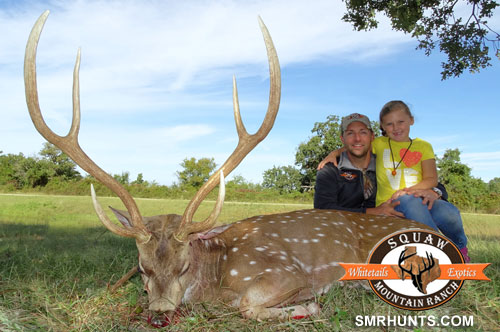Many hunters worldwide find axis deer, sometimes called chital deer, an enthralling and highly sought-after game species. Though they originated in the Indian subcontinent, these deer have been dispersed worldwide and are now thriving in the wild in Texas. There is an excellent place to hunt these amazing animals at Squaw Mountain Ranch. Gaining knowledge of their habits and habitat is essential for a successful axis deer hunt. With the information in this blog, hunters can maximize their experience by learning vital facts about axis deer.
Understanding the Behavior of Axis Deer
- Social Organization and Communication
Either a small herd of animals or a huge one might grow since axis deer are very social creatures. Males may move alone or form bachelor groups only during the rutting season. Typically, these herds are made up of females and their young. These herds must communicate to keep social ties strong and warn others of threats. Body language, including tail flicks and ear movements, is important in their interactions, and vocalizations like alarm calls, grunts, and bellows are usually heard.
- Feeding Behaviors
Although grazing is axis deer’s main activity, they also browse. Grass, foliage, fruits, and forbs comprise most of their food. When it is hot outside, they seek cover. Thus, they are most active in the early morning and late afternoon. Knowing the deer’s feeding habits can aid hunters in identifying good foraging sites.
- Reproductive Behaviors
Axis deer rutting season varies based on region but usually occurs in spring and summer. To get the attention of females, males during this time become louder and more combative. To identify and target mature bucks, hunters should take note of the heightened activity and vocalizations during the rut.
Habitat Preferences
- Terrain and vegetation
From grasslands and savannas to forested areas, axis deer are apex producers in various settings. They typically inhabit Texas regions with open grassland and dense vegetation. They have a wide variety of hiding places from predators, which enables them to graze and forage efficiently. The hunters’ main priorities should be the places that provide food sources and safe protection.
- Sources of Water
While choosing a habitat, axis deer must consider accessibility to water. In particular, in the summer, these deer require frequent hydration. For hunters, axis deer might be attracted to streams, rivers, ponds, and artificial water sources, which are great places to set up. An important source of knowledge on deer mobility patterns is the observation of trails that lead to and from these water sites.
- Seasonal Movements
Unlike other deer species, axis deer move seasonally due to environmental changes and food availability. However, they do not go on extensive migrations. While they might expand onto larger grazing areas during winter seasons, they might relocate closer to dependable water sources during dry conditions. By understanding these movements, hunters’ predictions on where the deer can be found will likely be at different times of the year.
Axis Deer Hunting Strategies
- Observation and Scouting Techniques
Complete scouting and observation are essential for axis deer hunting success. Become familiar with the terrain by locating pathways, feeding sites, and water sources. To observe deer behavior and patterns, use trail cameras and binoculars. The ideal times to observe are the morning and late afternoon when deer are most active.
- Choosing the Appropriate Gear
Given their excellent hearing and smelling senses, hunters require certain equipment to detect them. It is important to have scent-control items, silent footwear, and clothing that mix with the surroundings. Also, you can improve your hunting experience considerably by utilizing a dependable rifle or bow and the right optics.
- Callings and Decoys
Making calls to entice male deer can be a successful tactic during the rut. Atract bucks into range by mimicking a female or a competing male’s vocalizations. Additionally helpful, decoys can fool inquisitive or territorial males into investigating by simulating the presence of another deer.
Conclusion
Here at Squaw Mountain Ranch, axis deer present both a challenge and a reward for hunters. Hunting can become more effective and memorable if hunters understand their habits and preferred habitat better. Remember to conduct thorough scouting, use the appropriate equipment, and use decoy and calling tactics that work.
Axis Deer Hunting at Squaw Mountain Ranch: Are you Ready for the Excitement?
Schedule your experience now and apply what you have learned. Awaiting you are our knowledgeable guides and world-class hunting areas. For reservations and to start your journey on an incredible hunting adventure, visit our website or contact us. Any hunter may anticipate an interesting and fruitful axis deer hunt by heeding these suggestions and making the most of Squaw Mountain Ranch’s special opportunities.

